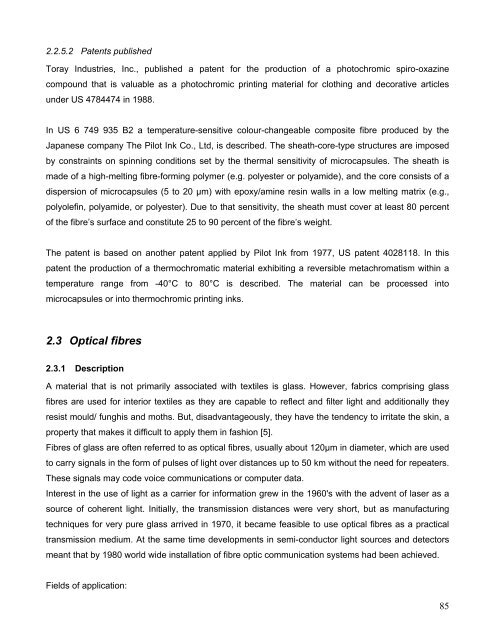Clevertex - Grado Zero Espace Srl
Clevertex - Grado Zero Espace Srl
Clevertex - Grado Zero Espace Srl
You also want an ePaper? Increase the reach of your titles
YUMPU automatically turns print PDFs into web optimized ePapers that Google loves.
2.2.5.2 Patents published<br />
Toray Industries, Inc., published a patent for the production of a photochromic spiro-oxazine<br />
compound that is valuable as a photochromic printing material for clothing and decorative articles<br />
under US 4784474 in 1988.<br />
In US 6 749 935 B2 a temperature-sensitive colour-changeable composite fibre produced by the<br />
Japanese company The Pilot Ink Co., Ltd, is described. The sheath-core-type structures are imposed<br />
by constraints on spinning conditions set by the thermal sensitivity of microcapsules. The sheath is<br />
made of a high-melting fibre-forming polymer (e.g. polyester or polyamide), and the core consists of a<br />
dispersion of microcapsules (5 to 20 µm) with epoxy/amine resin walls in a low melting matrix (e.g.,<br />
polyolefin, polyamide, or polyester). Due to that sensitivity, the sheath must cover at least 80 percent<br />
of the fibre’s surface and constitute 25 to 90 percent of the fibre’s weight.<br />
The patent is based on another patent applied by Pilot Ink from 1977, US patent 4028118. In this<br />
patent the production of a thermochromatic material exhibiting a reversible metachromatism within a<br />
temperature range from -40°C to 80°C is described. The material can be processed into<br />
microcapsules or into thermochromic printing inks.<br />
2.3 Optical fibres<br />
2.3.1 Description<br />
A material that is not primarily associated with textiles is glass. However, fabrics comprising glass<br />
fibres are used for interior textiles as they are capable to reflect and filter light and additionally they<br />
resist mould/ funghis and moths. But, disadvantageously, they have the tendency to irritate the skin, a<br />
property that makes it difficult to apply them in fashion [5].<br />
Fibres of glass are often referred to as optical fibres, usually about 120µm in diameter, which are used<br />
to carry signals in the form of pulses of light over distances up to 50 km without the need for repeaters.<br />
These signals may code voice communications or computer data.<br />
Interest in the use of light as a carrier for information grew in the 1960's with the advent of laser as a<br />
source of coherent light. Initially, the transmission distances were very short, but as manufacturing<br />
techniques for very pure glass arrived in 1970, it became feasible to use optical fibres as a practical<br />
transmission medium. At the same time developments in semi-conductor light sources and detectors<br />
meant that by 1980 world wide installation of fibre optic communication systems had been achieved.<br />
Fields of application:<br />
85

















